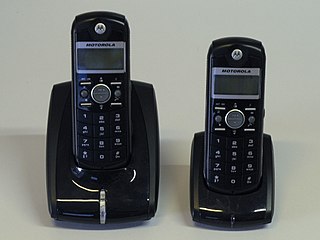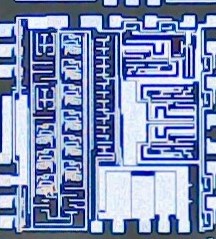Related Research Articles

A wireless network is a computer network that uses wireless data connections between network nodes.

In telecommunications, a repeater is an electronic device that receives a signal and retransmits it. Repeaters are used to extend transmissions so that the signal can cover longer distances or be received on the other side of an obstruction. Some types of repeaters broadcast an identical signal, but alter its method of transmission, for example, on another frequency or baud rate.

The R-S-T system is used by amateur radio operators, shortwave listeners, and other radio hobbyists to exchange information about the quality of a radio signal being received. The code is a three digit number, with one digit each for conveying an assessment of the signal's readability, strength, and tone. The code was developed in 1934 by Amateur radio operator Arthur W. Braaten, W2BSR, and was similar to that codified in the ITU Radio Regulations, Cairo, 1938.

Automatic gain control (AGC) is a closed-loop feedback regulating circuit in an amplifier or chain of amplifiers, the purpose of which is to maintain a suitable signal amplitude at its output, despite variation of the signal amplitude at the input. The average or peak output signal level is used to dynamically adjust the gain of the amplifiers, enabling the circuit to work satisfactorily with a greater range of input signal levels. It is used in most radio receivers to equalize the average volume (loudness) of different radio stations due to differences in received signal strength, as well as variations in a single station's radio signal due to fading. Without AGC the sound emitted from an AM radio receiver would vary to an extreme extent from a weak to a strong signal; the AGC effectively reduces the volume if the signal is strong and raises it when it is weaker. In a typical receiver the AGC feedback control signal is usually taken from the detector stage and applied to control the gain of the IF or RF amplifier stages.
This is an index of articles relating to electronics and electricity or natural electricity and things that run on electricity and things that use or conduct electricity.
IS-54 and IS-136 are second-generation (2G) mobile phone systems, known as Digital AMPS (D-AMPS), and a further development of the North American 1G mobile system Advanced Mobile Phone System (AMPS). It was once prevalent throughout the Americas, particularly in the United States and Canada since the first commercial network was deployed in 1993. D-AMPS is considered end-of-life, and existing networks have mostly been replaced by GSM/GPRS or CDMA2000 technologies.
A signal strength and readability report is a standardized format for reporting the strength of the radio signal and the readability (quality) of the radiotelephone (voice) or radiotelegraph signal transmitted by another station as received at the reporting station's location and by their radio station equipment. These report formats are usually designed for only one communications mode or the other, although a few are used for both telegraph and voice communications. All but one of these signal report formats involve the transmission of numbers.
Radiotelephony procedure includes various techniques used to clarify, simplify and standardize spoken communications over two-way radios, in use by the armed forces, in civil aviation, police and fire dispatching systems, citizens' band radio (CB), and amateur radio.

The base station subsystem (BSS) is the section of a traditional cellular telephone network which is responsible for handling traffic and signaling between a mobile phone and the network switching subsystem. The BSS carries out transcoding of speech channels, allocation of radio channels to mobile phones, paging, transmission and reception over the air interface and many other tasks related to the radio network.

A cellular network or mobile network is a communication network where the link to and from end nodes is wireless. The network is distributed over land areas called "cells", each served by at least one fixed-location transceiver. These base stations provide the cell with the network coverage which can be used for transmission of voice, data, and other types of content. A cell typically uses a different set of frequencies from neighboring cells, to avoid interference and provide guaranteed service quality within each cell.

A cordless telephone or portable telephone is a telephone which has a portable handset but which one can use like landline phone communication; such telephones operate using radio-frequency transmission rather than a physical insulated wire or a direct connection to a telephone line. A cordless telephone's base station connects with the telephone network through a telephone line and also includes a charger to charge the handset's batteries. The operational range is limited, usually to the same building or within some short distance from the base station.

A mixed-signal integrated circuit is any integrated circuit that has both analog circuits and digital circuits on a single semiconductor die.
Quality of service (QoS) mechanism controls the performance, reliability and usability of a telecommunications service. Mobile cellular service providers may offer mobile QoS to customers just as the fixed line PSTN services providers and Internet service providers may offer QoS. QoS mechanisms are always provided for circuit switched services, and are essential for non-elastic services, for example streaming multimedia. It is also essential in networks dominated by such services, which is the case in today's mobile communication networks.
Voice activity detection (VAD), also known as speech activity detection or speech detection, is the detection of the presence or absence of human speech, used in speech processing. The main uses of VAD are in speech coding and speech recognition. It can facilitate speech processing, and can also be used to deactivate some processes during non-speech section of an audio session: it can avoid unnecessary coding/transmission of silence packets in Voice over Internet Protocol (VoIP) applications, saving on computation and on network bandwidth.
The Mobile Telephone Service (MTS) was a pre-cellular VHF radio system that linked to the Public Switched Telephone Network (PSTN). MTS was the radiotelephone equivalent of land dial phone service.
Diversity combining is the technique applied to combine the multiple received signals of a diversity reception device into a single improved signal.
SINPO, an acronym for Signal, Interference, Noise, Propagation, and Overall, is a Signal Reporting Code used to describe the quality of broadcast and radiotelegraph transmissions. SINPFEMO, an acronym for Signal, Interference, Noise, Propagation, frequency of Fading, dEpth, Modulation, and Overall is used to describe the quality of radiotelephony transmissions. SINPFEMO code consists of the SINPO code plus the addition of three letters to describe additional features of radiotelephony transmissions. These codes are defined by Recommendation ITU-R Sm.1135, SINPO and SINPFEMO codes.
Procedure words are words or phrases limited to radio telephone procedure used to facilitate communication by conveying information in a condensed standard verbal format. Prowords are voice versions of the much older procedural signs for Morse code which were first developed in the 1860s for Morse telegraphy, and their meaning is identical.
A plain-language radio check is the means of requesting and giving a signal strength and readability report for radiotelephony (voice) communications, and is the direct equivalent to the QSA and QRK code used to give the same report in radiotelegraph communications. SINPEMFO code is the voice signal reporting format developed by the ITU in 1959, but sees little use outside of shortwave listeners.
The QSA code and QRK code are interrelated and complementary signal reporting codes for use in wireless telegraphy. An enhanced format, SINPO code, was published in the ITU Radio Regulations, Geneva, 1959, but is longer and unwieldy for use in the fast pace of Morse code communications.
References
- ↑ "Mobile Radio Estimates of Expected Coverage".
- 1 2 Bucher, John (1991). "An Overview of Cellular Telecommunications thesis" (PDF). Archived (PDF) from the original on February 18, 2017.
- ↑ Arokiamary, V.Jeyasri (2009). Cellular and Mobile Communications (First ed.). 1.4 Performance Criteria: Technical Publications Pune. p. 14. ISBN 978-81-8431-585-1 . Retrieved 27 March 2015.
{{cite book}}: CS1 maint: location (link) - ↑ Ballou, Glen (2015). Handbook for Sound Engineers. New York and London: Focal Press (Audio Engineering Society). p. 45.
- ↑ Federal Engineering, Inc. document.
- ↑ "Calculating signal to noise ratio" (PDF).
- ↑ "Circuit merit silliness".
- ↑ "Wetnet.net discussion thread on Circuit Merit".
- ↑ "Signal Reporting Using the Circuit Merit System" (PDF). Information Papers. Virginia RACES, Inc. May 2004. Retrieved 2015-02-08.
- ↑ "Plain Language Signal Reporting".
- ↑ "Plain Language Frequently Asked Questions (FAQs)" (PDF).
